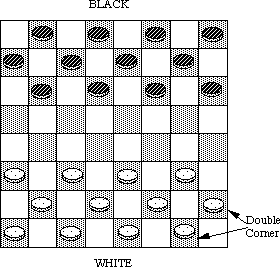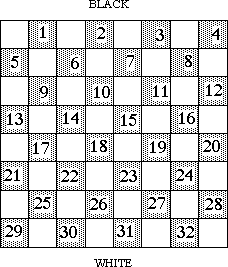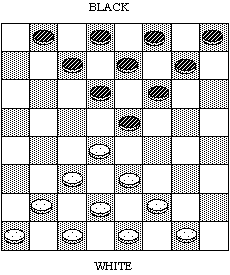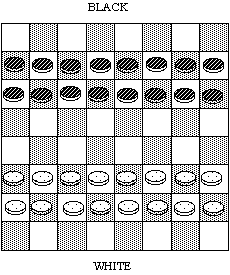 CS 596 OODP
CS 596 OODP
Checkers Description
[Project Index]
San Diego State University -- This page last updated Sept 26, 1995

Contents
- Checkers or Draughts
- EQUIPMENT
- PLAYERS
- THE PLAY
- OBJECT OF PLAY
- NOTATION
- VARIATIONS
- Pyramid
- Spanish Draughts
- Italian Draughts
- Polish Droughts
- Turkish Draughts
The following is copied from The New Complete Hoyle by Morehead, Frey,
Mott-Smith, 1956. The first variation described is sometimes called English
draughts or regular checkers.
The Checker Board is identical with the Chess board - a large square
composed of 8 x 8 smaller squares colored alternately dark and light. The board
is set between the two players in the same orientation as for Chess; all play
is conducted on the dark squares; consequently each player finds a double
corner near his right hand. The distinction between double corner and
single corner may be seen in Fig. 1.
The Checker Pieces are of uniform shape--wooden or composition disks at
least one inch in diameter and a little less than half as thick. Each player is
provided with twelve pieces of his own color. ( Actually, black and white
checkers are rarely seen. The usual combinations of colors are black and red,
or green and white. A set of Checker men always comprises fifteen pieces of
each color, so that it will serve also for Backgammon.) The initial position of
the pieces is shown in Fig. 1.

Figure 1. The Intial Position
The players sit on opposite sides of the board. They are designated as Black
and White, in accordance with the ( approximate ) color of the pieces used by
each. There is unfortunately no uniformity of style in printing diagrams, as to
whether the Black or White side is turned uppermost. In some books, Black is
always uppermost; in others, White; in many periodicals, the side whose turn it
is to move is placed at the bottom. The stipulation, such as "Black to move and
win," thus indicates which way the board is turned.
Black invariably makes the first move, and thereafter the players move
alternately.
The movement of the pieces is simple. A piece may move diagonally forward one
square, if that square is vacant. Or it may capture an adverse piece
which is adjacent, diagonally forward, if the square next beyond that piece is
vacant. The capture is executed by jumping over the adverse piece to the vacant
square and removing the enemy from the board. If the capturing piece lands on a
square from which another adverse piece is attacked in the same manner, it
continues jumping, in the same turn, to capture all adverse pieces it can. A
single man can capture a maximum of four pieces in one turn.
Away from the edge of the board, a piece can move in either of two directions.
In a series of captures, a piece may change direction at will from each landing
spot.
The primary rule of play is that, if able to do so, a player must capture
rather than make a non-capturing move. Among several possible captures, a
player may make a free choice. He is not compelled (as in Spanish Checkers) to
capture two pieces in preference to one. But a capturing piece may come to rest
only when unable to make any additional capture.
Crowning. All pieces on the board at the outset are single men. A single
man may move only forward. The row of squares at the Black or White edge of the
board is called the king row. On reaching the adverse king row, a single
man is crowned and becomes a king. Its promotion is indicated by placing upon
it a second checker of the same color. A player is required by law to crown the
adverse pieces that reach his king row.
A king has the same powers of move and capture as a single man, plus the
right to move backward as well as forward. If a single man reaches the king row
by capture, it has to stop to be crowned; it may not continue capturing (as a
king) in the same turn.
The object of play is to deprive the opponent of the ability to move in his
turn. This is usually accomplished by capturing all twelve of his pieces, but
it can also result from blocking his remaining pieces. The first player to find
himself unable to move in turn loses the game.
A draw results only by agreement, each player being satisfied that he
has no prospect of winning. If one player proposes a draw and the other refuses
to abandon play, the latter must within forty moves demonstrate an increase in
his advantage, or else concede the draw.
The notation used in recording games is based on numbering the squares as in
Fig. 2. A move is denoted by the number of the square moved from, followed by
the number of the square moved to, often joined by a hyphen. For example, the
seven moves open to Black at his first turn are: 9-13, 9-14, 10-14, 10-15,
11-15, 11-16, 12-16. Moves may written linearly, as in this example, or in a
column. No mark is attached to show whether a move is made by Black or White.
So long as there are no kings on the board, the numbers themselves show the
color of the move, for Black moves up and White down.

Figure 2. The Notation
An example of opening moves:
- 11-15
- 23-19
- 8-11
- 22-17
- 9-13
- 17-14
- 10-17
- 21-14
The last two moves are captures. No mark is used to indicate a capture; the
fact of capture is (except in long king tours ) evident from the difference
between the numbers. No noncapturing move can carry a piece to a square
differing by more than 5.
A symbol much-used in annotation is the star ( * ). A starred move is
the only one to win or to hold the draw.
Ten checkers are set up on each side, in the form of a pyramid. The Black
pieces are on 1, 2, 3, 4, 6, 7, 8, 10, 11, 15. All men move only forward, do
not crown, jump as in regular Checkers, but do not capture. That is, no pieces
are removed from the board. It is compulsory to jump when able, and as far as
able. The object of play is to maneuver one's own pieces to the squares
originally occupied by the adverse pyramid. The first to do so wins. If in the
course of play some pieces of one color are moved into a formation such that
not all of them can get within the objective area, that color loses at once.
For example, if White has moved pieces 3, 4, 8, and then is forced to jump
19-12, he loses, since the man on 12 cannot get inside the pyramid.

The Pyramid Game
Spanish Draughts is like the English game with the following differences:
1. With a choice of captures, a player must capture the maximum possible of
adverse pieces.
2. The king may move any distance along an open diagonal, and captures by
jumping to the adjacent vacant square beyond an adverse piece, any distance
away.
3. The double corner is placed at the players left.
Italian Draughts is like the English game with the following differences:
1. A single piece cannot capture a king.
2. With choice of captures, the player must capture with a king rather than
with a single man, and must take the maximum of adverse pieces, and must take
the most powerful if the number of adverse pieces concerned in the choice is
the same.
3. The double corner is placed at the player's left.
Polish Droughts is little known in Poland. It probably was named in the same
spirit as "Chinese Checkers" - to invoke the lure of the exotic. It is known to
have been played in Paris as early as 1723. The board is 10 x 10, and each side
has twenty pieces, set initially on the first four ranks. The rules are:
1. A single piece moves only forward ( diagonally ), but captures both forward
and backward.
2. A single piece that reaches the king row by capture and finds an adverse
piece adjacent ( with a vacant square beyond it ) must continue jumping in the
same turn.
3. A single piece is crowned and becomes a king ( actually it is called a queen
) only when it reaches the king row and can legally stop there.
4. With a choice of captures, the player must take the maximum possible number
of adverse pieces.
5. A king (queen) moves any distance along an open diagonal, and captures an
adverse piece any distance away by landing on any vacant square beyond it on
the same line. But the landing point must be chosen so as to enable the king to
continue jumping, and with the maximum of captures, when there is any choice.
6. Each captured piece is removed from the board before the captor continues
jumping; its removal may therefore open up additional captures previously
impossible.
Turkish Draughts differs from all other variants in that all 64 squares of the
8x 8 board are used. Each player has sixteen pieces, which are placed initially
on the second and third ranks. The rules are:
1. A single man may move one square forward on the file, or diagonally forward,
or sideward on the rank.
2. A single man captures in any of the same five directions; it must continue
jumping so long as possible.
3. With choice of captures, the player must take the maximum number of adverse
pieces.
4. A single man crowns on reaching the king row.
5. A king moves any distance on an open line in any direction, and captures by
jumping to the adjacent vacant square beyond an adverse piece, any distance
away.
6. Each captured piece is removed from the board before the captor continues
jumping; its removal may therefore open up additional captures previously
impossible.
 Turkish Draughts
Turkish Draughts


 CS 596 OODP
CS 596 OODP CS 596 OODP
CS 596 OODP